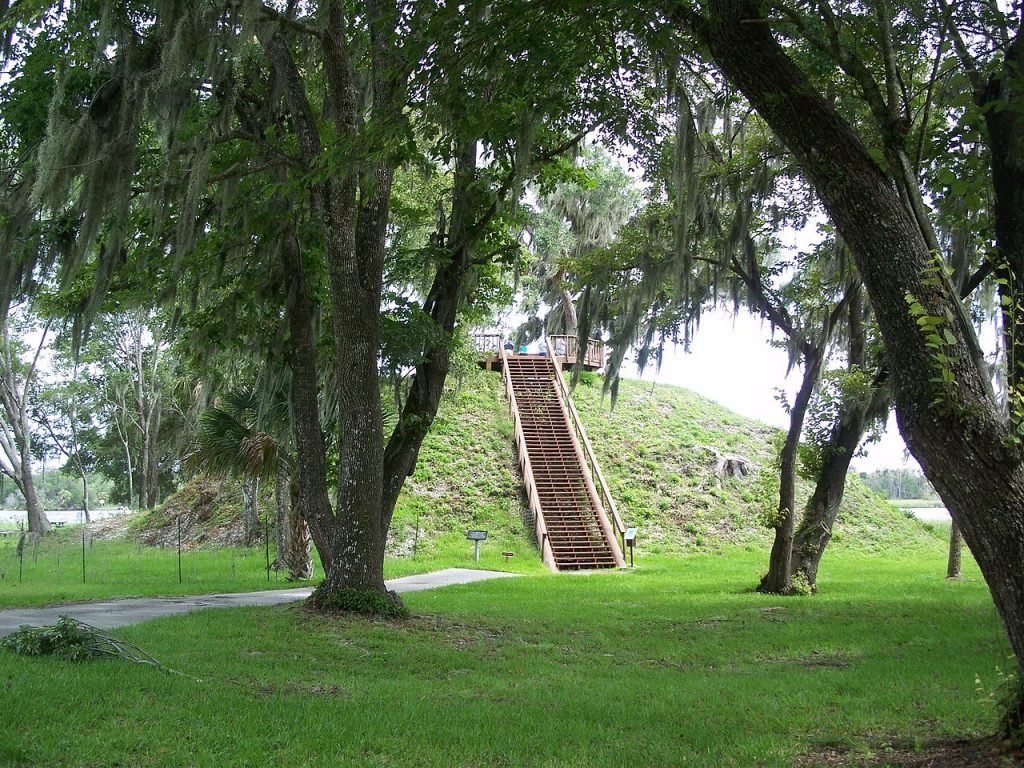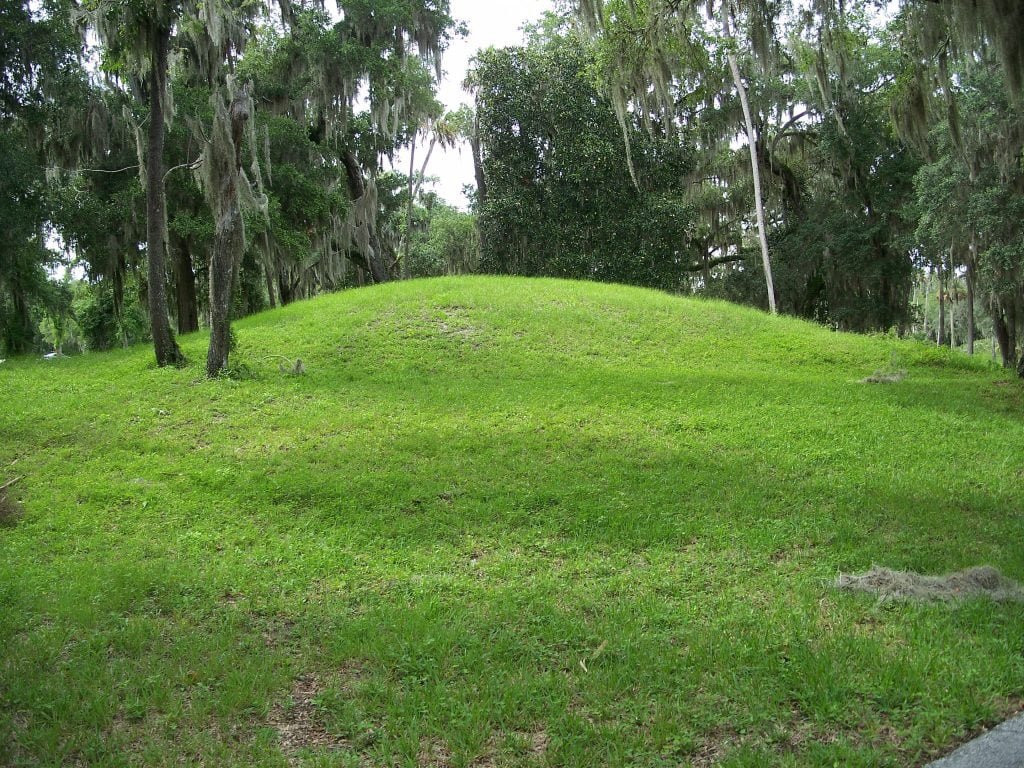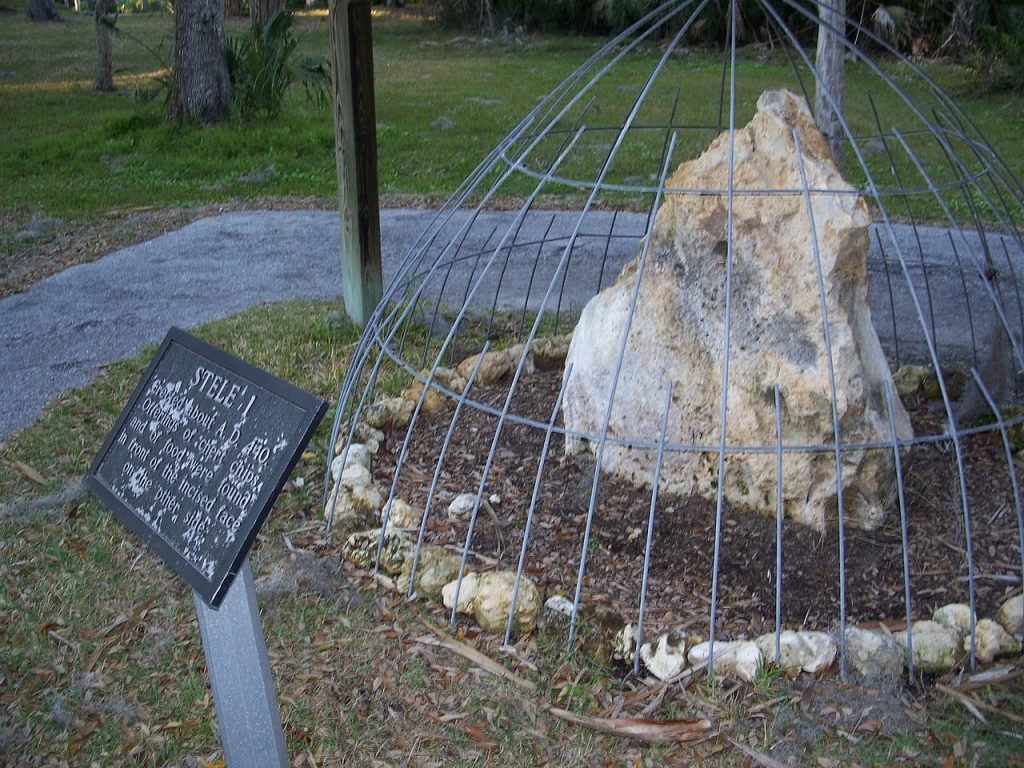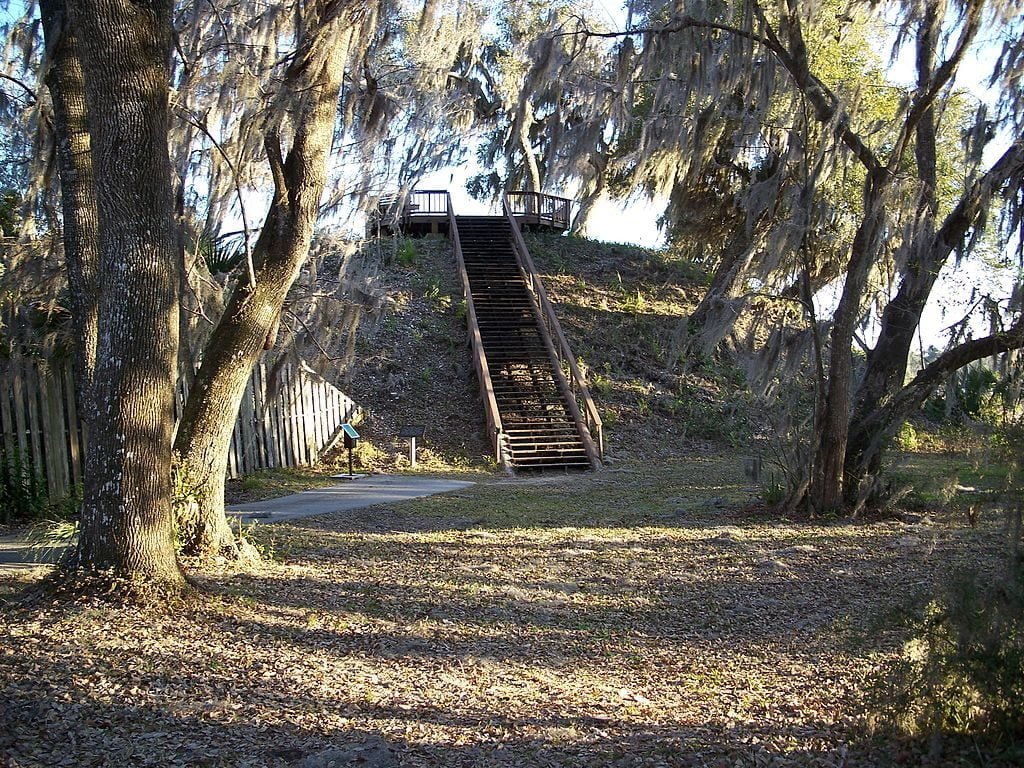The 61.55 acre Crystal River Archaeological Zone (8CL1) is located on the Crystal River within the Crystal River Preserve State Park. It is a National Historic Landmark and contains at least six mounds. This important Native American occupation site is located on the Central Gulf Coast of the Florida Peninsula, about 92 miles north of the mouth of Tampa Bay and 20 miles south of the mouth of the Suwannee River. It is possible to canoe on the Suwannee River to the Okefenokee Swamp in Georgia then on the St. Marys River to the Atlantic Ocean. This was a major trade route in pre-European times. The entrance to the park is about two miles northwest of the town of Chrystal River, off of US 19/98.
Native American Occupation of Crystal River Complex
Humans were probably living in the region around the archaeological site as least as early as 10,000 BC. However, the shore line of the Gulf of Mexico would have been as much as 100 miles to the west. The Crystal River would have been paralleled by bands of dense forests, but farther away the region would have been a savanna grassland. This was an ideal habitat for large mammals such as mastodons, giant sloths, giant beavers and giant bisons. These mammals would have been particularly vulnerable to human hunters, when walking through the dense forests to get water in the river.
The Crystal River Archaeological Zone is one of the longest continually occupied Native American sites in Florida. Archaeologists current believe that it was occupied for at least 1,900 years, perhaps longer. Native American cultural periods associated with this site include the Deptford, Swift Creek, Santa Rosa-Swift Creek, Weeden Island, Suwannee Valley, Safety Harbor and Fort Walton. These types of pottery have been found at the site.
Although the architecture and artifacts are similar to these cultural periods (mostly to the north) the town’s occupants were a maritime culture. They probably cultivated small gardens, but did not obtain a majority of their nutrition from farming. The soil along the Crystal River is not particularly well suited for the cultivation of corn, beans and most squashes. A small, sweet type of squash, essentially a small pumpkin, will thrive on the Florida Gulf Coast. Nevertheless, most of their nutrition was from fish, shellfish, aquatic animals, live oak acorns and wild fruits.
Archaeologists believe that the location was a regional mortuary complex. It is not known at the current time why this location was so culturally important that people wanted to be buried there. They estimate that at least 7,500 people a year visited the mound complex to participate in rituals and dances, plus bury their dead. During the Hopewell Cultural Period (0 AD – 550 AD) these people also participated in a long distance trade network. Many of the burials contain copper tools and ornaments from the Ohio River Basin and Upper Midwest. Burials also include crystals and mica ornaments from the Southern Appalachians. After 550 AD, the burials did not contain artifacts from the Midwest. Some burials did not contain any artifacts.
Architectural Features of Crystal River Complex
The Crystal River Complex contains burial mounds, temple or domiciliary platform mounds, a sand-shell ring, a raised platform, a plaza area, a garbage midden and four crudely carved stone monuments. The stone monuments are called “stellae” at the park, but they bear little resemblance to Mayan stelae. It is estimated that at least 1200 to 1500 bodies were buried at the site.
The earliest structure was a conical burial mound, which dates back to around 250 BC. This date corresponds to the earliest known permanent agricultural village in northern Georgia, “Sweet Potato Village – 9FU14.” There is possibly a cultural connection between the two sites, because both initially produced Deptford Style pottery.
The sand and shell ring has a feature that has not yet been explained by archaeologists. Layers of human remains were placed in layers of sand. Most of the layers were veneered with shells. Some were not.
The largest platform mound (Mound A) is a truncated pyramid with a ramp and dates from around 500 AD. It was originally about 30 feet higher than top of the midden. It is about 200 feet long and 100 feet wide.
Another large mound is called Mound H. Archaeologists do not know exactly when it was built or what it was used for. It is shaped like a square and is 235 feet long. It also has a ramp, so its use was possibly ceremonial. This mound is built entire of sand.
As more and more burials were made in the conical mound and sand ring, a raised platform, containing burials developed between the two structures. The platform contains burials, but apparently also was used for communal feasts. Two large platform mounds are believed to have been used primarily for ceremonial purposes or the residences of priests.
There is extensive evidence throughout the site of large scale consumption of food. The refuse from these feasts created a midden. This garbage consists of various kinds of animal bones, fish bones, turtle shells, broken pottery, broken hand tools and arrowheads. By the time of abandonment, the midden had reached a length of 1,300 feet, a width of 100 feet and a depth of 7 feet. Its final form was a crescent shape.
There were definitely three carved limestone boulders on the site, and probably a fourth one that is no longer visible. One of the boulders is crudely carved as the face of a man or woman, with long flowing hair draped over the shoulder. Such crude stone carvings are fairly common in the Caribbean Basin and northern South America, but this one is unique for Florida. Numerous, sophisticated stone statues, however, have been found in northern Georgia.
During the past thirty years, several writers have speculated that Crystal River was a location where Maya immigrants settled, because the archaeologists labeled the stone boulders, stelae. However, neither the carved stone boulders nor the site plan of Crystal River Mounds are similar to Maya towns. The proto-Muskogean towns in Georgia, Alabama, East Tennessee and western North Carolina were much more similar to those of the Maya culture. They were similar to the towns of the Chontal and Itza Mayas, not the Classical Maya cities.





